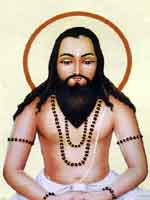Religious Mentors
Satya se dharti bane, Satya se bane Akash
Satya se Shrishti upje, Kaha gaye Ghasidas.

Guru Ghasi Das (1756 – 1850CE) was an advocate of the Satnami sect of Hinduism in the early 19th century. Ghasi Das was a farmer in Girodpuri, Raipur district who preached Satnam to a number of low-caste Indians, particularly the people of Chhattisgarh. Ghasi Das's guruship was carried on by his son, Balakdas, Guru Ghasidas (1756-1836) was the founder of the Satnami community in Chhattisgarh. He was born in the village Girodhpuri in the Raipur district. During his lifetime, the political atmosphere in India was one of exploitation. Ghasidas experienced the evils of the caste system at an early age, which helped him understand the social dynamics in a caste-ridden society and reject social inequity. To find solutions, he traveled extensively in Chhattisgarh.
Saint Guru Ghasidas established Satnami community in Chhattisgarh, India based on "Satnam" (meaning "Truth") and equality. The Guru's teachings and philosophy is similar to Buddhism. He opposed all Hindu beliefs and cultures including idol (Murti) puja. He has nothing to with Hinduism. Guru ghasidas gives a symbol called "jaitkhambh" that is a straight piece of wood and white in colour having white flag on a top That indicates the a man who follow truth or satnaam who is always like that symbol which is steadfast no one can break it..that means pillar of truth (satya ka stambh) And flag indicates the peace.
Satnam Dharm
The word Dharm is a sanskrit word, which is a combination of two words, Dharan (accept) and Aham ( me, my) The combined word means "I accept". Satnam Dharm means I accept and follow Satnam.
Teachings of Guru Ghasidas can be summarized into one word: Satnam, ( satnaam ) meaning "True Name". The name of the lord is considered as the sole truth and the seed of the universe and everything else sprang from it. In modern times the word "satnam" is chanted along with the name of sikh guru, Guru Nanak Dev as "Satnam Vahe Guru". In modern hinduism it is believed that during the Kalyuga, chanting the name of Lord is the only way of offering any prayers to the lord. All other forms of offering prayers to the Lord will either become too difficult , for example Tapasya, or will become too influenced by lack of knowledge.
Followers of Satnam believe in the name of the Lord and do not worship idols. They follow practices similar to Buddhism.
